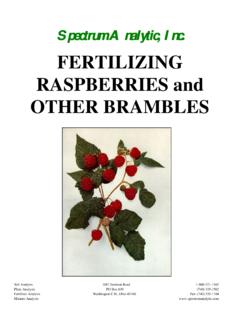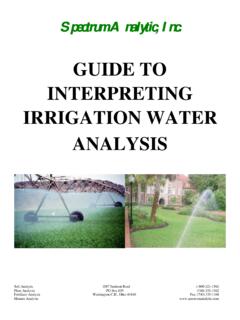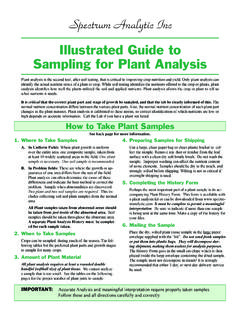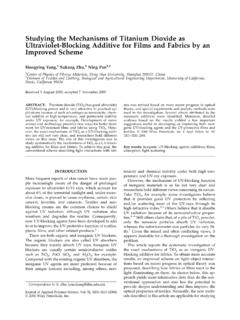Transcription of Spectrum Analytic Inc
1 Spectrum Analytic Inc. FERTILIZING ALFALFA Soil Analysis 1087 Jamison Road 1-800-321-1562 Plant Analysis PO Box 639 (740) 335-1562 Fertilizer Analysis Washington , Ohio 43160 Fax: (740) 335-1104 Manure Analysis 2 Table of Contents 3 Soil pH ..pg 5 Nitrogen ..pg 6 General Phosphorous and Potassium ..pg 7 Phosphorous ..pg 8 Potassium ..pg 12 Calcium ..pg 15 18 21 Micronutrients General ..pg 22 23 26 Manganese ..pg 28 Zinc ..pg 30 Iron ..pg 32 Molybdenum ..pg 34 36 Recommended Practices for Top Yielding 38 3 Introduction Alfalfa can produce exceptionally high yields when given the right conditions.
2 Some examples of high, non-irrigated alfalfa yields are seen in the following tables. Non-Irrigated Year Location Yield (T/acre)1981-82 (2 Yr. avg.) Michigan State Univ 1982 Michigan State Univ. 1985 Univ. of Wisconsin 1987 Univ. of Maryland 1987 Delaware State Irrigation and long growing seasons increase the yield potential. In the 1981-82 growing season, researchers at the University of Arizona, Yuma Valley Agricultural Center produced the current world-record alfalfa yield with tons/acre. Before you get too excited about growing 20 T/ac of alfalfa, you should know that the Arizona yield occurred where they had a 12 month growing season and they were able to take 10 cuttings during the year.
3 Even with the advantage of irrigation and a year-long growing season, this was excellent alfalfa, as evidenced by the ton/cutting average. In a 4-cut/yr Midwestern program the Arizona yield roughly equals a yield of T/ac. While not everyone can produce yields like these, they demonstrate the tremendous yield potential of alfalfa. To better appreciate these high yields, they can be compared to the average yields in other states. As you can see, the state average yields are well below what is possible. Incomplete data for later years suggests that average yields across the country have not changed significantly from those presented here in more recent years.
4 However, years like 2004 with better rainfall show higher average yields. Alfalfa Statistics 2001, 2002 Yield (T/ac) Yield (T/ac) Yield (T/ac) State 2000 2001 State 2000 2001 State2000 2001 AZ MA OK AR MI OR CA MN PA CO MO RI CT MT SD DE NE TN ID
5 NV TX IL NH UT IN NJ VT IA NM VA KS NY WA KY NC WV ME ND WI MD OH WY Some will ask if higher yields are actually profitable.
6 Each grower will have to do his own math, but most calculations show that the cost of inputs for a higher, but attainable yield is an excellent investment. If only the fertilizer program is changed, you are not as likely to achieve higher yields. Higher yields are typically the result of a coordinated production program where different inputs and management practices 4compliment each other. Most authorities recommend the following practices in addition to proper lime and fertilizer programs. Select well drained land Take soil samples to determine the fertilizer program Use certified, inoculated seed of an adapted variety (with proven high yield potential) Band seed with press wheel and starter fertilizer at the appropriate rate, date, and depth Apply proper fertilizer rates (replacement plus buildup) in annual split applications Reduce competition: control weeds and do not plant a companion crop Control insects, especially potato leaf hopper Harvest on time In the following pages we will focus on alfalfa fertility.
7 At the end of the paper there is a short discussion on several of the other aspects of alfalfa production. You will find many pictures of visual nutrient deficiency symptoms in the following pages. Please understand that visual nutrient deficiency symptoms are a sign of severe problems. You should never see nutrient deficiencies in any crop! You cannot expect high yields when a crop goes through a period of starvation! This is why plant analysis is so important. Plant analysis is the only way to identify nutrient stress before visual starvation symptoms appear.
8 5 Soil pH The first goal of any alfalfa fertility plan is to get the soil pH into the correct range. While some authorities suggest that alfalfa soil needs a pH around and some respectable yields can occur at this pH, most high alfalfa yields occur at soil pH s around Maintaining a soil pH at, or slightly above can cause micronutrient shortages in some soils. Therefore, it is important to counter this with appropriate fertilizer programs. See the section on micronutrients for suggestions. 6 Nitrogen (N) Alfalfa utilizes about 56 lb of N/ton of yield. Do your own arithmetic and you will see that any high yield requires large amounts of N.
9 Luckily; alfalfa is very efficient at N fixation. In nearly all typical farming situations, nitrogen will not be needed for alfalfa after it is established. Spectrum Analytic recommendations suggest that 20-30 lb. N/acre be applied at seeding, (crop codes 10 and 134 for fall seeding and spring seeding respectively) and none thereafter. This is consistent with a number of Universities. However, for alfalfa to produce the large amount of needed N, it requires adequate amounts of other nutrients. Over the years, a number of research projects have looked at applying N to established alfalfa.
10 The theory apparently being that legumes must have an upper limit for N production, and N might limit yields at some point. Given that alfalfa contains about 56 lb. N/ton and there have been yields of 10 to 12 T/acre yields produced without added N, alfalfa appears capable of producing the approximate 550-670 lb. N/acre needed for those yields. The majority of research results into adding supplemental N to established alfalfa found that the extra N provided no benefit to yield or quality. In some cases, yield and/or quality was reduced by additional N. However, some record yields have received high rates of N.











